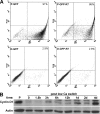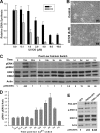Protein kinase D is implicated in the reversible commitment to differentiation in primary cultures of mouse keratinocytes
- PMID: 20463010
- PMCID: PMC2906330
- DOI: 10.1074/jbc.M110.105619
Protein kinase D is implicated in the reversible commitment to differentiation in primary cultures of mouse keratinocytes
Abstract
Although commitment to epidermal differentiation is generally considered to be irreversible, differentiated keratinocytes (KCs) have been shown to maintain a regenerative potential and to reform skin epithelia when placed in a suitable environment. To obtain insights into the mechanism of reinitiation of this proliferative response in differentiated KCs, we examined the reversibility of commitment to Ca(2+)-induced differentiation. Lowering Ca(2+) concentration to micromolar levels triggered culture-wide morphological and biochemical changes, as indicated by derepression of cyclin D1, reinitiation of DNA synthesis, and acquisition of basal cell-like characteristics. These responses were inhibited by Goedecke 6976, an inhibitor of protein kinase D (PKD) and PKCalpha, but not with GF109203X, a general inhibitor of PKCs, suggesting PKD activation by a PKC-independent mechanism. PKD activation followed complex kinetics with a biphasic early transient phosphorylation within the first 6 h, followed by a sustained and progressive phosphorylation beginning at 24 h. The second phase of PKD activation was followed by prolonged ERK1/2 signaling and progression to DNA synthesis in response to the low Ca(2+) switch. Specific knockdown of PKD-1 by RNA interference or expression of a dominant negative form of PKD-1 did not have a significant effect on normal KC proliferation and differentiation but did inhibit Ca(2+)-mediated reinitiation of proliferation and reversion in differentiated cultures. The present study identifies PKD as a major regulator of a proliferative response in differentiated KCs, probably through sustained activation of the ERK-MAPK pathway, and provides new insights into the process of epidermal regeneration and wound healing.
Figures






Similar articles
-
The potential use of protein kinase D inhibitors for prevention/treatment of epidermal tumors.J Dermatol Sci. 2010 Oct;60(1):29-39. doi: 10.1016/j.jdermsci.2010.07.015. Epub 2010 Aug 10. J Dermatol Sci. 2010. PMID: 20832999 Free PMC article.
-
Opposing growth regulatory roles of protein kinase D isoforms in human keratinocytes.J Biol Chem. 2015 Apr 24;290(17):11199-208. doi: 10.1074/jbc.M115.643742. Epub 2015 Mar 23. J Biol Chem. 2015. PMID: 25802335 Free PMC article.
-
Regulation of protein kinase D during differentiation and proliferation of primary mouse keratinocytes.J Invest Dermatol. 2005 Aug;125(2):294-306. doi: 10.1111/j.0022-202X.2005.23780.x. J Invest Dermatol. 2005. PMID: 16098040
-
Putative conventional protein kinase C inhibitor Gödecke 6976 [12-(2-cyanoethyl)-6,7,12,13-tetrahydro-13-methyl-5-oxo-5H-indolo(2,3-a)pyrrolo(3,4-c)-carbazole] stimulates transglutaminase activity in primary mouse epidermal keratinocytes.J Pharmacol Exp Ther. 2002 Jul;302(1):352-8. doi: 10.1124/jpet.302.1.352. J Pharmacol Exp Ther. 2002. PMID: 12065737
-
Protein kinase D and keratinocyte proliferation.Drug News Perspect. 2004 Mar;17(2):117-26. doi: 10.1358/dnp.2004.17.2.829045. Drug News Perspect. 2004. PMID: 15098066 Review.
Cited by
-
Emerging roles of protein kinase D1 in cancer.Mol Cancer Res. 2011 Aug;9(8):985-96. doi: 10.1158/1541-7786.MCR-10-0365. Epub 2011 Jun 16. Mol Cancer Res. 2011. PMID: 21680539 Free PMC article. Review.
-
Protein kinase D1 deficiency promotes differentiation in epidermal keratinocytes.J Dermatol Sci. 2014 Dec;76(3):186-95. doi: 10.1016/j.jdermsci.2014.09.007. Epub 2014 Oct 2. J Dermatol Sci. 2014. PMID: 25450094 Free PMC article.
-
Construction and Validation of a UPR-Associated Gene Prognostic Model for Head and Neck Squamous Cell Carcinoma.Biomed Res Int. 2022 Jun 6;2022:8677309. doi: 10.1155/2022/8677309. eCollection 2022. Biomed Res Int. 2022. PMID: 35707371 Free PMC article.
-
Ultraviolet activation of PKD: implications for skin cancer.Future Oncol. 2011 Apr;7(4):485-7. doi: 10.2217/fon.11.16. Future Oncol. 2011. PMID: 21463136 Free PMC article. No abstract available.
-
Calcium-based nanoparticles accelerate skin wound healing.PLoS One. 2011;6(11):e27106. doi: 10.1371/journal.pone.0027106. Epub 2011 Nov 2. PLoS One. 2011. PMID: 22073267 Free PMC article.
References
-
- Fuchs E. (1990) Curr. Opin. Cell Biol. 2, 1028–1035 - PubMed
-
- Crish J. F., Bone F., Balasubramanian S., Zaim T. M., Wagner T., Yun J., Rorke E. A., Eckert R. L. (2000) Carcinogenesis 21, 1031–1037 - PubMed
-
- Carroll J. M., Romero M. R., Watt F. M. (1995) Cell 83, 957–968 - PubMed
-
- Hennings H., Michael D., Cheng C., Steinert P., Holbrook K., Yuspa S. H. (1980) Cell 19, 245–254 - PubMed
-
- Dotto G. P. (1999) Crit. Rev. Oral Biol. Med. 10, 442–457 - PubMed
Publication types
MeSH terms
Substances
Grants and funding
LinkOut - more resources
Full Text Sources
Other Literature Sources
Molecular Biology Databases
Research Materials
Miscellaneous

